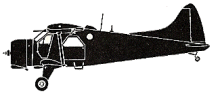
ASN Wikibase Occurrence # 244245
This information is added by users of ASN. Neither ASN nor the Flight Safety Foundation are responsible for the completeness or correctness of this information.
If you feel this information is incomplete or incorrect, you can submit corrected information.
| Date: | Monday 7 March 2005 |
| Time: | c. 11:00 LT |
| Type: |  de Havilland Canada DHC-2 Beaver |
| Owner/operator: | Fly Denali |
| Registration: | N3307S |
| MSN: | 1092 |
| Year of manufacture: | 1957 |
| Total airframe hrs: | 9768 hours |
| Engine model: | Pratt & Whitney Canada R-985 |
| Fatalities: | Fatalities: 0 / Occupants: 4 |
| Aircraft damage: | Substantial |
| Category: | Accident |
| Location: | 43 miles NE of Talkeetna, Alaska -
 United States of America United States of America
|
| Phase: | En route |
| Nature: | Passenger - Non-Scheduled/charter/Air Taxi |
| Departure airport: | Talkeetna, Alaska |
| Talkeetna, Alaska | |
| Investigating agency: | NTSB |
| Confidence Rating: |
On March 7, 2005, about 1100 Alaska standard time, a de Havilland Beaver DHC-2 airplane, N3307S, sustained substantial damage during an in-flight occurrence of aerodynamic flutter, about 43 miles northeast of Talkeetna, Alaska. The airplane was being operated by Fly Denali, Inc. of Talkeetna, as a visual flight rules (VFR) sightseeing flight, at the time of the accident. The airline transport pilot and the three passengers were not injured. Visual meteorological conditions prevailed, and company flight following procedures were in effect.
During a telephone conversation with the National Transportation Safety Board (NTSB) investigator-in-charge (IIC) on March 7, the pilot said the flight was approaching Mt. McKinley from the northeast at 11,000 msl when the airplane started to shake violently. He said he could not control the airplane, and elected to shut down the engine in the event the engine was the cause of the problem. He said when the shaking did not stop, he slowed the airplane to about 80 mph, and the shaking subsided. He said he restarted the engine, and flew to Talkeetna at a slow airspeed, with flaps extended. A postlanding inspection revealed that both wings were structurally damaged. The pilot said that prior to the mishap, there were no known problems with the airplane.
Prior to the initiation of the flutter event, the pilot said he had been taking a digital video with audio through the window of the airplane. At the outset of the event, the pilot said he dropped the camera, which continued to record. A copy of the recording was sent to the NTSB recorder laboratory in Washington, D.C. for review. The portion of the recording prior to the flutter event shows the airplane in a wings level attitude in VFR conditions with clouds in the vicinity. When the camera was dropped to the floor, it continued to record the sounds of the event. The audio portion of the recording revealed a vibration for about 3 to 7 seconds in the 8.2 to 8.4 Hz range, which according to the recorder specialist, is within the 5-10 Hz range for the normal wing bending/torsional first mode of vibration. There was nothing on the recording to indicate the airplane was being flown outside the normal operating envelope prescribed by the airplane's manufacturer.
The airplane was examined by aerospace engineers from the Anchorage, Alaska, FAA Aircraft Certification Office (ACO), who noted that the damage to the airplane indicated that the rear spars of both wings oscillated up and down with significant amplitude at span station 92.5. They noted that the bushing holes in the rear spar attachment fittings were elongated, which, according to the engineers, if preexisting, would have been a major contributing precipitator of the flutter. Additionally they found that both the right aileron and rudder were severely under-balanced. They were not able to ascertain if the aileron cable tension was adequate prior to the event.
Both the pilot and passengers alluded to turbulence in the area prior to the flutter event. An image from a polar orbiting satellite showed cloud banding in the area at the time of the accident, indicative of mountain wave generated turbulence.
On February 1, 1980, de Havilland Aircraft of Canada, Limited, issued Service Bulletin 2/29 for the DHC-2 airplane. The service bulletin indicated that instances of aileron/wing flutter had been reported, and that at least two or more conditions out of four must be present to facilitate a flutter condition. The four conditions were: ailerons not balanced; aileron cables in the wing slack; deterioration in the stiffness of the aileron mounting structure in the fuselage; and/or the airplane being flown outside the limits of the flight manual.
On February 20, 1980, in response to de Havilland's service bulletin, the FAA issued Airworthiness Directive AD 80-24-02, which required mandatory inspections of the airplane's wings, spars, and aileron cable tension and balance, within a prescribed timeframe, based on service hours and part numbers.
Accident investigation:
 |
|
Sources:
https://www.ntsb.gov/about/employment/_layouts/ntsb.aviation/brief2.aspx?ev_id=20050314X00308&ntsbno=ANC05LA046&akey=1
https://www.aopa.org/news-and-media/all-news/2006/march/01/never-again-online-denalis-rough-ride
Media:
Revision history:
| Date/time | Contributor | Updates |
|---|---|---|
| 20-Oct-2020 07:46 | harro | Added |
Corrections or additions? ... Edit this accident description
The Aviation Safety Network is an exclusive service provided by:


 ©2024 Flight Safety Foundation
©2024 Flight Safety Foundation